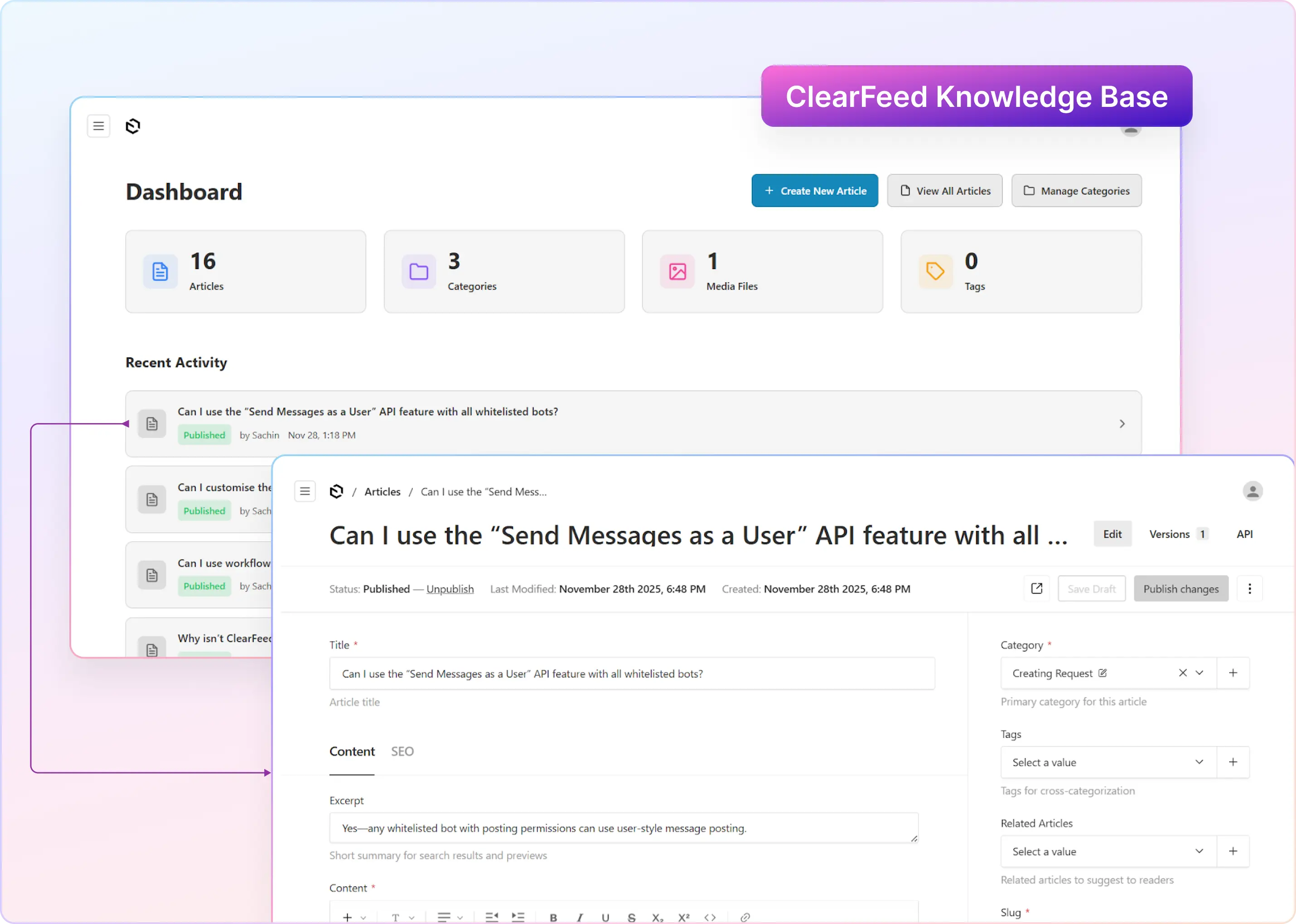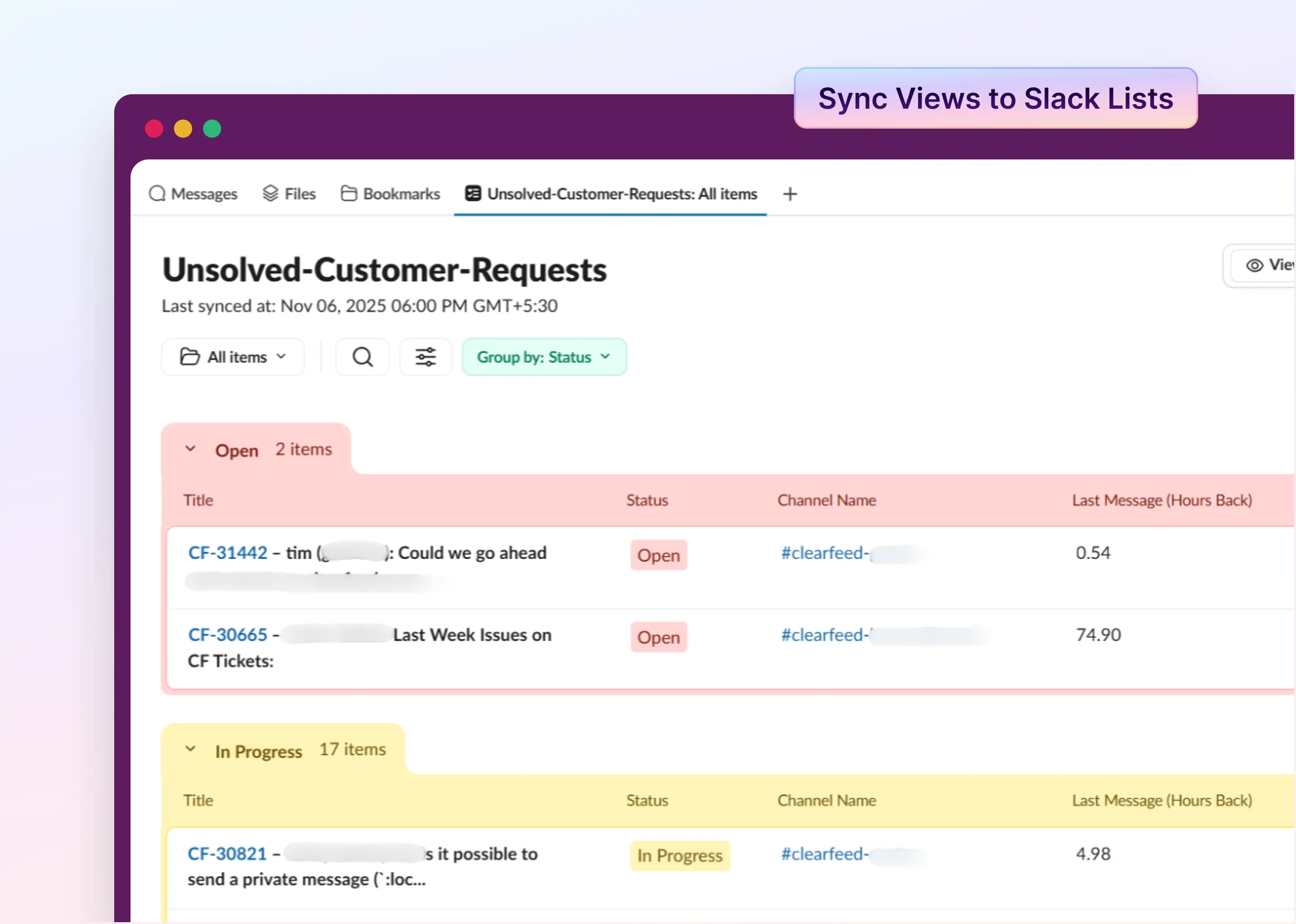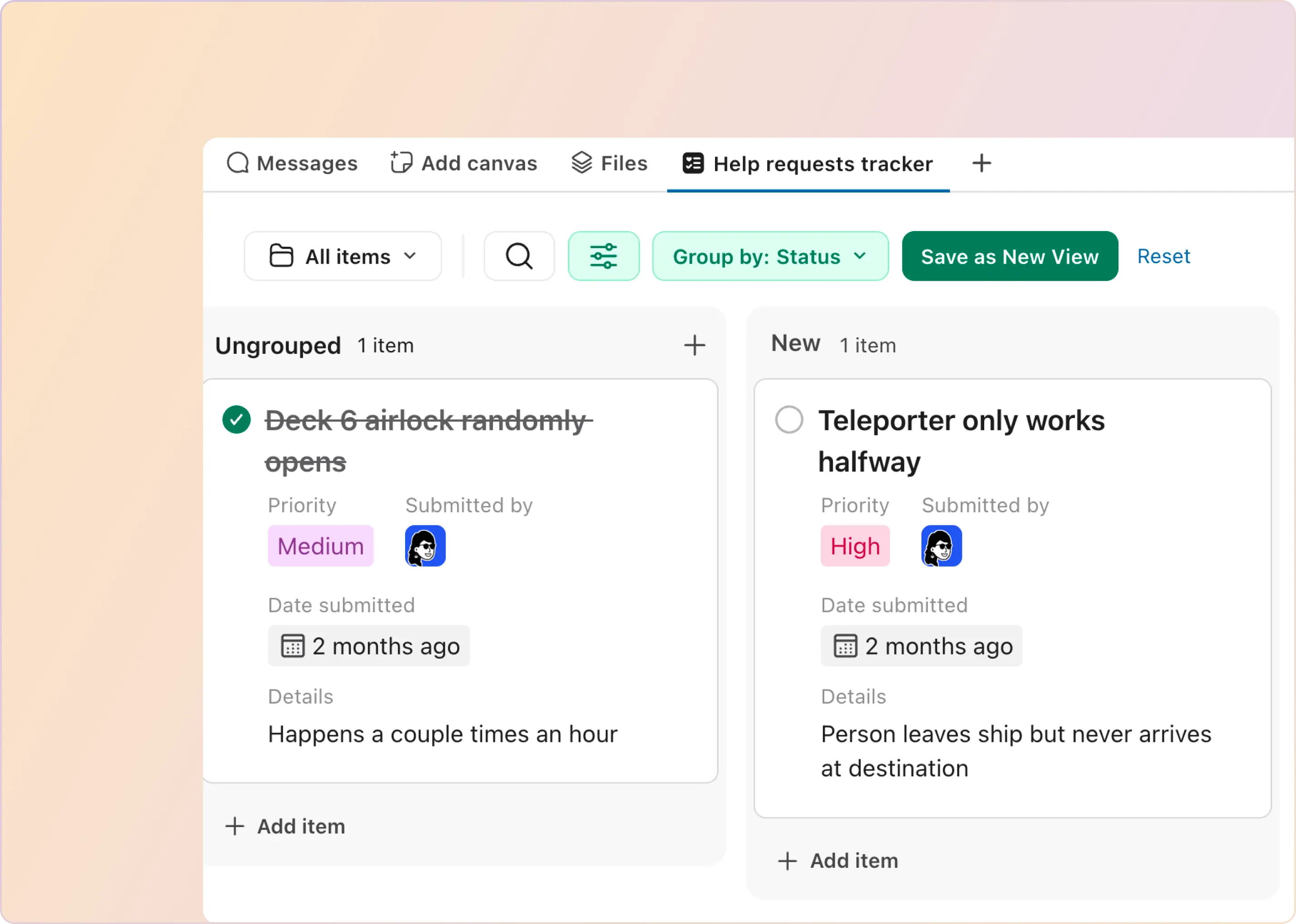Introduction
At ClearFeed, we specialize in helping companies scale their Slack Connect channels with customers. Being practitioners of what we preach, we leverage these shared Slack channels to engage and support our customers. Slack Connect can be a tad complex to understand and set up for unfamiliar people. In this article, we're sharing a brief overview of how Slack Connect works and some of the best practices we've gained from managing many shared channels.
To make the guide easy to read, we have broken it into different sections, with some frequently encountered questions within each. The sections are listed below (readers can jump directly to the one of interest):
- What Is Slack Connect
- Understanding the Invitation Process
- Security in Slack Connect Channels
- Managing Applications in Slack Connect Channels
- Best Practices for managing Slack Connect channels, MSTeams etc.
What Is Slack Connect and How Does It Work?
Slack Connect is a powerful feature that builds upon Slack's core capabilities, enabling more than intra-organizational communication. At its essence, Slack Connect is designed to foster collaboration between multiple organizations within the familiar Slack interface.
Beyond just messaging, it allows file sharing, app integrations, and all the other functionalities you'd expect from a Slack channel, but with the added benefit of cross-organizational collaboration. Slack Connect allows different organizations to create shared channels. One organization creates a shared channel (the Channel Owner) - and invites others to it.
Are “Slack Connect” and “Shared Channels” the same thing?
Yes - shared channels evolved into Slack Connect. They function like normal channels connecting organizations and are now part of Slack Connect.
How Many Organizations Can Participate in a Slack Connect Channel?
A single Slack Connect channel can host up to 250 different organizations. This makes it a potent tool for large-scale collaborations, joint ventures, or any situation where multiple external partners must be in sync.
How Many Slack Connect Channels Can Two Organizations Have?
Two organizations can create as many Slack Connect channels between themselves as they want. It is a common misconception that there can only be one Slack Connect channel between two collaborating organizations. Different channels can be very useful for collaborating on projects or between different teams between the two organizations.
Is Slack Connect Free?
Unfortunately, no! Slack Connect requires a paid Slack subscription and all organizations participating in a Slack Connect channel have to be on paid plans. However the creator can add Guests as participants - and they can participate for free if they are Single-Channel Guests.
What is the price of Slack Connect?
There is no separate price for Slack Connect. Slack Connect is available with all paid Slack subscriptions. This does mean that the organization has to pay for every user in the Slack workspace that needs Slack Connect. The price for this starts approximately $7/user (and may depend by region). Note that invited external users to a Slack Connect channel also have to be on a paid Slack subscription.
There are two ways of reducing the Slack subscription fees:
- Keep your full team on a free Slack workspace and get a paid Slack workspace only for the employees who need to use Slack Connect with customers or partners.
- In addition, for customers or partners who are not on a paid Slack subscription - invite them as Single Channel guests.
How can one use Slack for External Communication ?
Slack's preferred way for External Communication is to use Slack Connect. Paid Slack subscriptions can invite other Paid Slack Subscriptions to a Slack Connect channel and communicate across organizations easily. An alternative, when one of the participants is not on a Paid plan is to use Single or Multi-Channel Guests. Both these techniques allow collaboration using the full suite of Slack’s products like Canvas, Lists and Huddle. While Slack also has some level of Email integration, it is really not meant for Email based communication with Customers and requires add-ons like Front, MailClark or ClearFeed to facilitate that. Similarly, using Slack to communicate with customers or partners on MS Teams, Discord, Whatsapp or Telegram requires additional software.
What Are Some Alternatives to Slack Connect?
The allternative to Slack Connect is using Single-Channel Guests in Slack. If your partner organization doesn’t have a paid Slack workspace - you can invite them as Guests to your workspace. If you only invite them to one channel - they can be treated as Single Channel guests in your workspace and are free. Just like in Slack Connect - direct messages between the host organization members and the guests are also possible.
However - note that inviting guests is also a feature in paid Slack workspaces only. ie. - you still need a paid Slack subscription to invite guests (even though your guests do not). Another alternative to Slack Connect is Microsoft Teams. This is discussed later in this blog.
What Are the Differences Between Slack Connect and Single Channel Guest Users?
The most important difference between Slack Connect and Guest users is cost. External organizations in a Slack Connect channel have to be on a paid plan - while single channel guests invited to it can be from free workspaces. However - other than this - Slack Connect has many advantages over Guest Users in terms of billing, cost, security, and managing applications:
- Billing and Cost: Each participating organization pays for their members in Slack Connect, unlike Guests - where the host organization must pay for guests (in case they are multi-channel guests).
- Data Control and Security: Slack Connect channels allow granular control over what profile and message data is visible to external users. Similarly, Slack Connect doesn’t allow external users to use the apps installed by other organizations. This prevents the possibility of unauthorized data access using shared Apps.
- Applications and Workflows: A guest user in Slack has access to the apps of the host organization - but they can neither install apps nor have access to apps they are used to in their workspace. Slack Connect solves this problem by allowing external users to install and use apps on the Slack Connect channels.
- Management Overhead: Managing guests can become cumbersome, especially in a large organization. Regularly reviewing and updating guest permissions, ensuring they're in the right channels, and setting expiration dates require consistent oversight. By contrast, once a Slack Connect channel is set up, management overhead is often reduced since each organization manages its members.
How Many Single Channel Guests Can I Add to Slack?
Single Channel guests are free in Slack for a paid Slack workspace. For every paid member in a workspace - Slack allows 5 free single-channel guests. If you are paying for 5 members in Slack -you can add up to 25 free single-channel guests. So you can add a lot of free guests to your Slack workspaces - but not infinite.
How is pricing handled for multi‑channel guests versus full members in Slack Connect scenarios?
Multi‑channel guests are billed as paid members under Slack’s Fair Billing Policy, while single‑channel guests are free; Billing is by the host workspace for its paid member types. This also means that if you want to invite external users using the Guest approach for collaboration - free collaboration is only possible if they are limited to one channel.
How Many Slack Connect channels can I have?
There is no limit to the number of Slack Connect channels a Slack workspace can have! It just needs to be on a paid subscription. At ClearFeed, we have several hundred Slack Connect channels ourselves and several of our customers have 1000+ Slack Connect channels. Managing a large number of channels can be difficult and software like ClearFeed is almost critical to managing a large number of Slack Connect channels.
Can I rename a Slack Connect channel?
Yes! The initial name of a Slack Connect channel is determined by the organization that creates the channel. But the external organization can rename the channel while accepting the invite (or later) as seen in the screenshot below. Any such renaming only affects the name in the external organization. So collaborating teams using Slack Connect may have a different notion of the name of their shared channel!

Understanding the Invitation Process
How to Create a Slack Connect Channel?
Also asked: How to add an External Connection to Slack?
A Slack Connect channel, or an External Connection in Slack, is just a regular Slack channel with users from multiple organizations. To create a Slack Connect channel (ie an external connection in Slack) and share it with external organizations or users, follow these steps:
- Open Slack and Choose a Channel: Start by opening your Slack workspace. Go to the channel you want to share or create a new one.
- Click on 'Add People': In the top right corner of the screen, you'll see thumbnails of the current channel participants. Click on those thumbnails and then click on 'Add People.'
- Add External Users to the Channel: Just add an external email id to the channel.
When the external user joins the channel - the channel becomes a Slack Connect channel. Alternatively - if you accept a Slack Connect invite and join an external organization's Slack Connect channel - that also shows up as a Slack Connect channel in your workspace.
How to Send an Invite to Customers on Slack?
Once you've prepared your Slack Connect channel, you can invite external users:
- Enter the Partner's Email: Provide the partner's email address you want to invite. This should be the email they use for their Slack workspace.
- Send the Invitation: Click 'Send' once you've entered the email. An invitation will be sent to the partner's Slack workspace.
Who Can Send a Slack Connect Invite?
All workspace members (other than guests) can send invites by default. However, depending on your workspace settings, this may be limited to the admins and specific members. In this case, the administrators must approve the external invitation.
What Happens to a Slack Connect Invite After It Is Sent?
All workspace members (other than guests) can receive and accept an invite by default. However, admins of the receiving organization can limit this permission - in which case specific members of the receiving organization must accept the invitation.
What If a Slack Connect Invitation Is Not Accepted?
One common issue we've observed is the "expired invites" phenomenon. Because invitations may require an approval process, or partners might overlook the initial invitation due to the myriad of emails they receive daily, invitations often go unresponded. Fortunately, Slack provides a notification of expired invitations (as shown in the screenshot below).

We advise users to watch for these expired invitation notifications and resend invitations. In our experience - sending the invitation multiple times is often required before successfully connecting.
What causes Slack Connect invite failures besides expiry, and how can I diagnose them?
Some common causes for the invites failing include:
- The external organization has a policy requiring approvals and no one approved the invite.
- The external organization has disabled Slack Connect.
- The external organization may be on a free‑plan with no access to Slack Connect.
What Is a Channel Owner in Slack Connect?
The workspace that initiates the invite becomes the owner of a Slack Connect channel. This is important to understand because the owner of the Slack Connect channel has additional privileges. The channel owner can be seen in the channel details (from Desktop ->Right Click on channel name ->View channel details) as shown below:
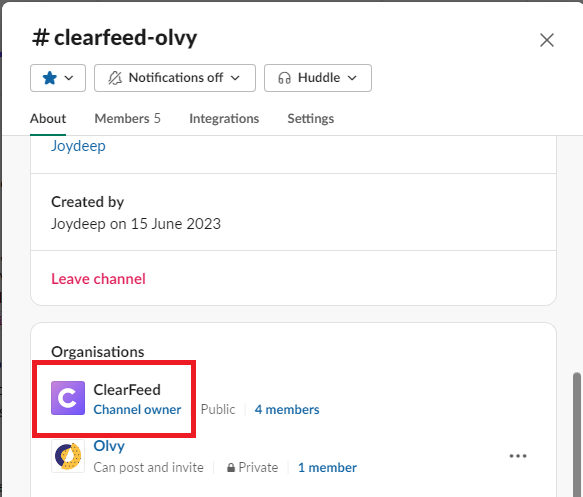
Can Slack channel ownership be transferred between organizations after creation?
Slack Connect channels can have different settings per org, but ownership transfer isn’t exposed as an admin action in public documentation. Contact Slack Support for help on specific cases.
Who Should Initiate the Invite in a Shared Channel?
Many Slack Connect channels are between two collaborating organizations. A vendor (or an agency) often collaborates with their customer (or client). While either party can create the channel and extend the invitation to the other, we recommend that the vendor start the channel and extend the invitation to their customer. There are a couple of key reasons:
- One is ensuring the vendor is the channel owner and can install important apps (like ClearFeed) to manage Slack Connect channels. If the customer initiates the connection and is the channel owner, they can turn off the vendor's ability to install apps.
- Equally importantly - we have found Slack Connect to be an outstanding tool for customer engagement, and it’s in the vendor's interest to initiate these connections as soon as they engage with a prospect.
I suddenly got removed from a Slack Connect channel. What should I do?
There are a few reasons why this can happen:
- The external organization may have archived or deleted the Slack Connect channel - thereby removing all external participants. In this case you should reach out to the channel owner via Email or other means to check if this was accidental.
- Your Slack workspace may have been downgraded to a free tier. If this happens, you will be removed from all external Slack Connect channels that you are part of. Or for Slack Connect channels owned by you - external users would be removed. In this case, after restoring the paid subscription, you have to be invited back to any external Slack Connect channels (or invite external participants back to yours).
How can I remove an external connection in Slack?
Once a connection is no longer required between two companies in Slack, one of them may wish to remove themselves from the channel. There are two different ways to do this:
- Everyone from your organization leaves the Slack Connect channel. This can be done by simply typing /leave in the channel.
- Alternatively - you can ask the channel owner to archive or delete the Slack Connect channel. This automatically removes all external participants (inclding your org) from the channel.
- Finally - you Slack workspace administrator can remove the external connection through the admin interface. (See next question as well).
How can I see all the Slack Connect channels in my workspace?
If you are a Slack workspace administrator - you can see all the Slack Connect channels from the Administrator section > "Slack Connect connections" when you manage your Slack account from the browser. You can also see all the Slack Connect invites from this panel. As an admin, you can disconnect Slack Connect channels anytime - an example screenshot is below:
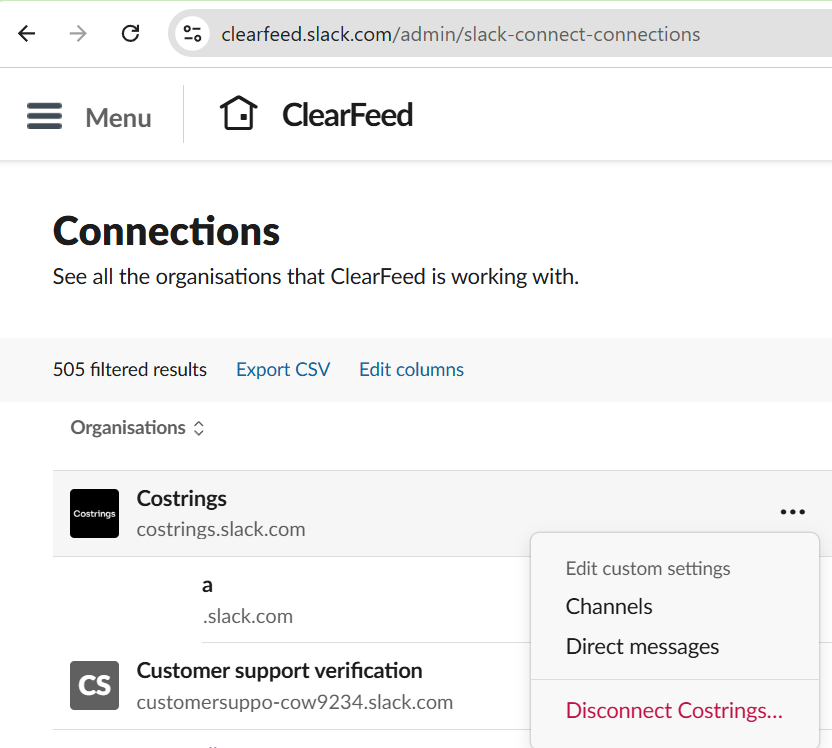
What does “Your admins have disabled Slack Connect channels” mean?
It indicates org/workspace policies require approval or disallow Slack Connect. Owners/Admins can enable and configure approvals and auto‑accept rules in Slack Connect settings, so the path is to request policy changes or approval from the admin or the right person in the team.
Security for Slack Connect Channels
Regarding inter-organizational collaboration, security remains paramount. Slack recognizes this and has integrated various controls for admins regarding Slack Connect channels. Let's delve into the specifics of these controls:
What Profile Information Is Visible to External Users in Slack Connect?
Only the email address, name, and profile pictures are default visible to external organizations in shared channels.
- Admins can decide whether additional profile information like title, status, and pronouns are shared with external partners.
- They can also turn off email information being visible to partners.
This article contains instructions for controlling these options. The default sharing options for profile information are shown below:
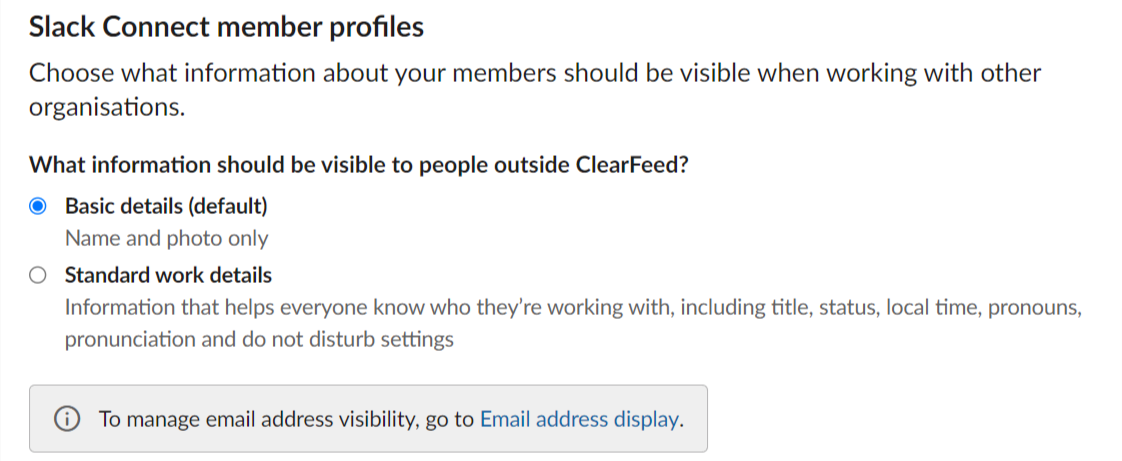
Can external participants see presence or status, and can admins restrict visibility?
Presence/status and profile detail visibility of workspace users for external users is governed by admin‑controlled profile and Connect visibility settings. Only Email, Name and Profile pictures are visible by default - not presence or status. Admins have the ability to turn on Status and Presence visibility as described in the previous section.
Can External Users Access Custom Emojis of Your Workspace?
No. If you have custom emojis in your workspace, you can only use them. External users invited via Slack Connect cannot use them - they are not available in the emoji picker for external users. However - if you use custom emojis in shared channels - those emojis are visible to external users. Note that Guest users have access to your workspace emojis (and this is yet another example of how Slack Connect is better from a security perspective).
Who Can Add Members to Slack Connect Channels?
The channel owner of the Slack Connect channel (i.e., the organization that initiated the invite) can add any member they want. By default, partner organizations can also add members freely - however, this can be changed by the channel owner.
How Can We Prevent External Users from Adding Members and Apps to Slack Connect Channels?
One can do this by changing the privileges of an external organization in a Slack Connect channel. The steps to do this are as follows:
- From Desktop: ‘Right-click’ and go into ’Channel Details’
- Scroll down in the details to where the partner organizations are listed.
Click on the ‘...’ menu next to a partner organization and change their privileges as shown in the screenshot below:
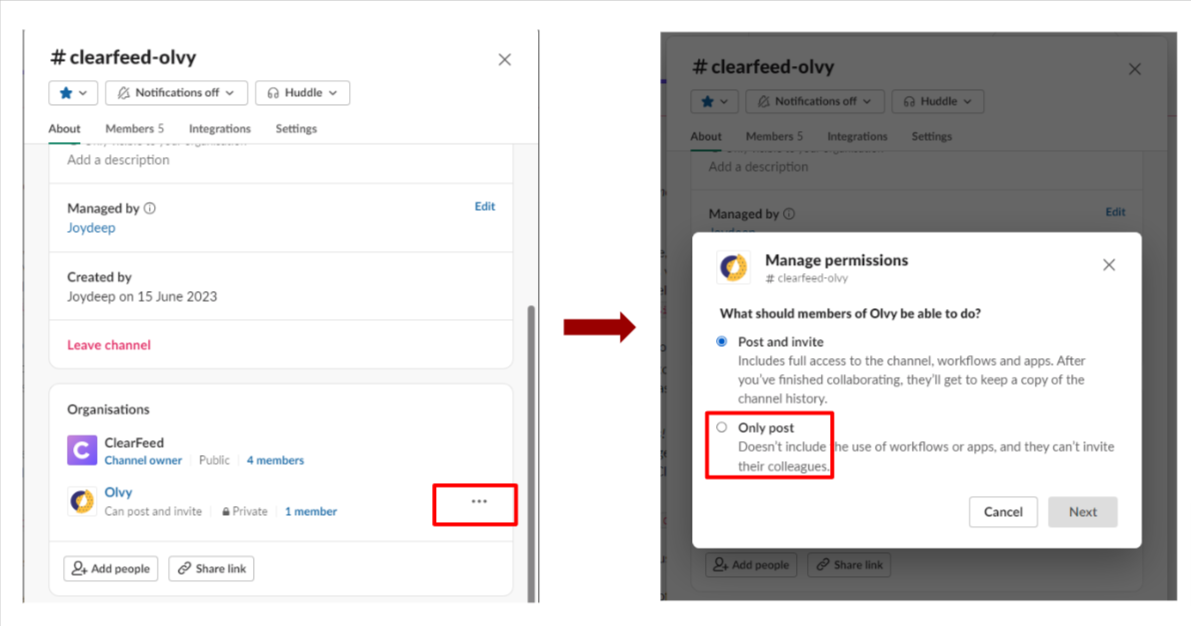
By restricting the partner organization to only posting privileges - one can ensure they cannot invite additional colleagues or apps to the channel.
I am unable to add Apps or invite Users to Slack Connect channel - what can I do?
This frequently happens if the Slack Connect channel was created by an external organization and you were not granted Post and Invite permissions by the Channel Owner. Here's what to do in such cases:
- To invite another user from your organization - contact the Slack Connect channel owner and ask them to invite the user directly.
- To add an app - you must ask the channel owner to, at least temporarily, grant you invite privileges. They can revoke the privilege once the app has been installed by you.
- Note: you cannot ask them to install the app directly - since the app may not even be available in their workspace. Or even if available - apps installed by one organization are not available to others and are associated with different accounts in the application (eg - your Jira Slack App and the external organization's Jira Slack app are associated with different Jira accounts)
- You can also ask the channel owner to extend you post/invite privileges to solve this problem on a more permanent basis.
Note that not having invite privileges also affects access to data in the Slack Channel if it is deleted by the host organization at some point.
Can external users on Slack Connect see my User Groups?
External users cannot join or see user groups outside their workspace. ie. - if you have setup a Slack Connect channel - then external users present in that channel will not be able to see your org’s user groups. That also means that user groups cannot be tagged - and users must use tags like @channel or @here to address all the participants in the Slack Connect channel.
How Long Are Messages Retained in a Slack Connect Channel?
By default - messages shared in a Slack Connect channel are retained forever. However, each participant organization in a Slack Connect channel can control the retention of messages they send. This can be changed by one of the two methods:
Method 1: The message retention setting for the entire workspace can be changed. This can be done by changing the ‘Message History’ settings in the Workspace settings as detailed here.
Method 2: However - the above option is not very practical as admins may want a different setting for Slack Connect channels (as opposed to internal channels). This can be done, at a per channel level, via a two-step process:
- Firstly, by allowing individual members to override the message retention settings at the channel level. This can also be done in the ‘Message History’ section described above, as shown in the screenshot below:

- With this change affected, individual channel owners can now go to a specific Slack Connect channel, open its Settings (via ‘Right Click’ -> ‘View Channel Details’ ->‘Settings’ from the Desktop), and then change the ‘Message History’ setting as shown below.
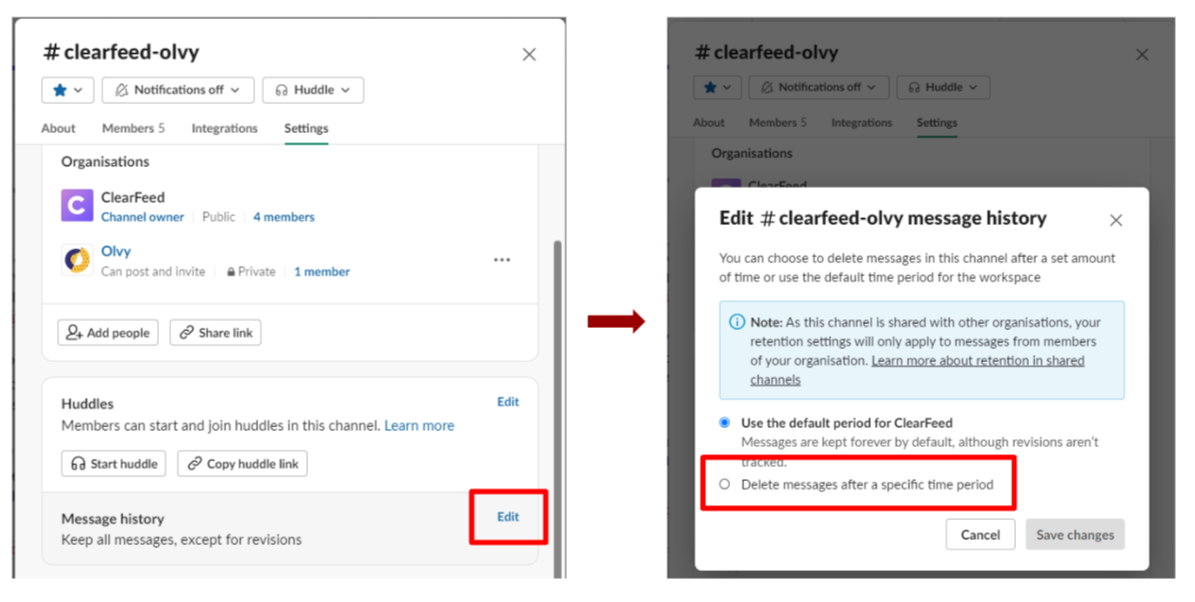
Unfortunately, at this moment, there does not seem to be a global setting specific to all Slack Connect channels. This is one of the ways software like ClearFeed helps companies by easily applying global policies and actions across multiple Slack Connect channels.
In conclusion, Slack makes it very easy to collaborate - and that means it’s easy to send messages and attachments - including ones that may be confidential. Businesses are naturally wary of sharing data outside the company firewall - and Slack Connect channels expose yet another potential point of confidential data leakage.
Slack offers a comprehensive suite of security controls, allowing organizations to balance collaboration and security. It's always essential for admins to familiarize themselves with these controls and adjust settings in alignment with their organization's security policies and requirements.
How do retention settings interact when each organization sets different policies in the same Slack Connect channel?
Each organization’s retention applies only to its own members’ messages/files. External org content follows their policies, and channel‑level overrides apply per org’s scope. The mechanism to change the retention settings at an org level are listed above.
What happens when a Slack Connect Channel is deleted?
If the host who started the Slack channel deletes it, what happens to other organizations in that channel depends on their permissions:
- Participants with Post and Invite permissions: will continue to see an archived version of that channel. Retention settings would apply wrt actual data that is visible.
- Participants with Post privileges only: will not have access to the channel or its data - it will be completely gone from their workspace.
What happens when a Slack Connect Channel is archived?
Any of the organizations in a Slack Connect channel can archive it. That disconnects them from the Slack Connect and archives the channel in their workspace. All the apps from their workspace are also removed from that channel. However other organizations continue to see the channel in their workspace. They will see a message posted on their copy of the Slack Connect channel noting that an external organization has left the channel.
Is It Possible to Disable Direct Messages in Slack Connect?
By default, members who join a Slack Connect channel from external organizations can send direct messages to other members in that channel. This can be difficult to manage (DMs can go unattended) and represents another vulnerability that allows information sharing across companies without visibility to the rest of the organization.
Administrators can disable Slack Connect DMs. However, it is also extremely useful to be able to send private messages in Slack (not everything can be discussed in shared contexts), so admins may want to check with their team on whether limiting DMs is an appropriate choice for your team.
Can Single‑Channel Guests send DMs - does that differ from Slack Connect DMs?
Guests can use DMs per standard DM rules, while cross‑org DMs are governed by Slack Connect DM settings (as described above) that admins can enable/disable and control. So Slack Connect gives much more control over DMs for external users than Guests in Slack workspaces.
Can external users in a Slack Connect channel join User Groups?
No. External users can neither see the Slack User Groups of other organizations -nor can they be added any User Groups of a different organization.
Managing Applications in a Slack Connect Channel
Applications can greatly enhance the functionality and productivity of a Slack workspace and play a significant role in Slack Connect channels. But who can install these apps and how they behave in a shared environment differs from regular channels.
Who Can Install Applications in a Slack Connect Channel?
By default, workspace administrators or members with specific permissions of each organization in a Slack Connect channel can install apps in that channel. However, if the Channel Owner has restricted an organization from inviting users, it won’t be able to add applications.
Can Different Organizations Install the Same App in a Slack Connect Channel?
Yes! The same application can be installed individually by different organizations, and its functionality can only be used by that organization. Let’s take an example:
- Acme Corp and Beta Corp are both members of a Slack Connect channel, ABC
- Acme installs the Giphy app in channel ABC
- Beta Corp can also install the Giphy app in channel ABC
Acme and Beta Corp members can use the Giphy app now (say - using its shortcuts). But when they use the app - they are using their installation of the Giphy app.
How Do We See All the Apps Installed in a Slack Connect Channel?
All the applications installed in a Slack Connect channel can be seen from that channel's Integrations tab (from the Desktop - Right Click -> View Details -> Integrations). As the Slack documentation says, “Apps added by another organization will include that organization's Slack icon next to the app name. Only people from the organization that added an app can remove it from a channel.”
Can Apps Installed by One Organization Be Used by Another in a Slack Connect Channel?
The general answer is no, with one exception:
- The shortcuts for an app are only visible to the organization members who installed the app in the Slack Connect channel. For example, to interact with the Giphy app, one could use the /giphy shortcut. If only one of the organizations has installed the Giphy app, only they can use this shortcut.
- Similarly, apps often publish actions via a “three dots” menu next to every message. Those are also only available to the organization that has installed the App.
- However, messages posted by Apps on a shared channel are visible to all participants. So one must be careful with Apps installed on such channels - while they may not be directly accessible to external participants, the messages they post are.
- Workflows are also available to all participants on the channel.
- External Slack Connect members can also open apps installed by the host organization. They can do so by finding the app by going to the Channel Integrations (see previous section). As an example - the ClearFeed app installed by a company (named Sprinto in this case) is visible to external members as follows. However note that it's functionality is very limited, users can only message the app.

How can one create Tickets in a Slack Connect channel?
Slack does not have a native concept of Tickets. Users looking to track important customer messages can use Save Later feature of Slack - or use a shared Slack List with customers. Major Ticketing systems (like Zendesk) often provides a Slack app that provides some basic level of integration between Slack channels and the ticketing platform. However users looking for a more comprehensive ticketing functionality (or integration) built into Slack should consider using ClearFeed which provides advanced features like Forms, automatic ticketing and seamless two-way sync of Slack threads and Tickets built into Slack.
What are the best‑practices for Customer Channels?
Some best practices for Customer Channels include:
- One channel per customer - which a clear and consistent naming pattern that marks it as a customer channel. Example "ext-<customername>"
- If one decides to have an internal triage channel for some customers - name them differently and consistently as well, for eg: "int-<customername>"
- Setup pinned welcome messages on each customer channel.
- Setup automations to send welcome messages to new channel participants.
- Use a Support platform that excels at managing conversations on Slack, MS Teams etc (like ClearFeed)
A longer list on best practices is available at this article: Guide to Customer Support on Slack.
What Are Some Tools to Manage Slack Connect Channels?
Slack Connect is an amazing tool for inter-organizational collaboration, vastly superior to email. However, as we've learned at ClearFeed, it's often difficult to understand some of its key concepts and manage a growing number of channels. This is where tools like ClearFeed come in.

ClearFeed is an AI-powered customer and employee support platform for Slack. It can
- Monitor messages across scores of Slack channels and convert them into a shared queue of tasks.
- Provides alerts whenever any conversation needs attention.
- Helps convert customer Slack conversations into tickets.
- Provides the ability to set up automated answers from knowledge bases.
- Make announcements across dozens of Slack Channels in one shot.
It has helped numerous organizations scale up and manage Slack Connect channels for customer support.
Microsoft Teams
While Slack is extremely popular, MS Teams is even more so. But they do not seamlessly interoperate (unlike - say - email). Companies using Slack
Is Microsoft Teams an alternative to Slack Connect?
Yes! One can also work with external organizations using MS Teams. Just like Slack, MS Teams allows adding external users as guests - or connecting with their workspace using MS Teams Shared Channels. On our blog - we have published a short guide on how to use Microsoft Teams for Customer Support.
Can we setup an external connection from Slack to Teams?
MS Teams and Slack do not connect natively. But it is possible to link MS Teams to Slack using third party tools like ClearFeed. For example - an organization that uses Slack, can chat with customers on MS Teams channels from Triage channels in Slack using ClearFeed. This can allow employees to stay focused on Slack, while customers who use MS Teams, can use their favorite platform of choice. Checkout our broader guide on how to Integrate Slack and Microsoft Teams.
Other Guides for Scaling Slack Connect
Beyond mastering Slack Connect - we have also written some other tutorials around differen aspects of using Slack for Customer Support and Engagement. These include:
- Guide to Integrating Email and Slack: If you work with customers over both Email and Slack - this is a Guide on how to bring them together.
- Free Tools to automate Actions across Slack Connect channels: A collection of free browser apps to perform actions across lots of Slack Channels at once.
- Guide for using Slack Connect for Customer Support. It's a must-read for users looking to scale Slack Connect channels with customers and partners.
- Maximizing Customer Success with Slack: Hear how customer success leaders in leading technology companies leverage Slack with customers.
Have any questions about Slack Connect or scaling CS on Slack? You can connect with us on our Community Slack, email us at support@clearfeed.ai, or visit us at https://clearfeed.ai.






